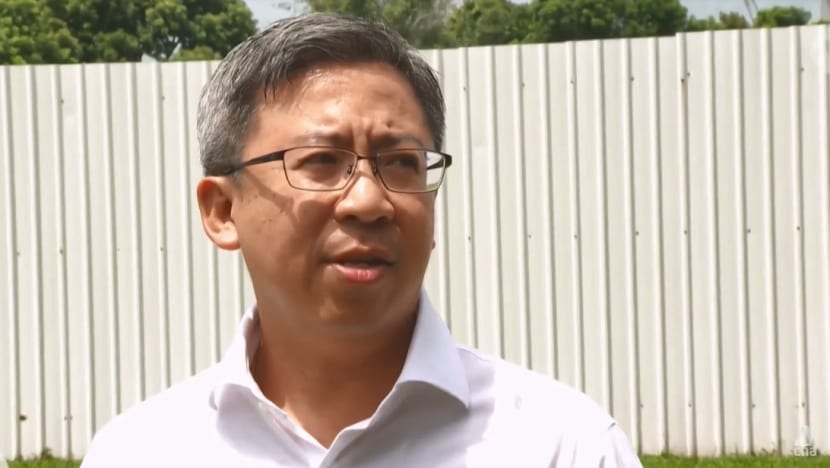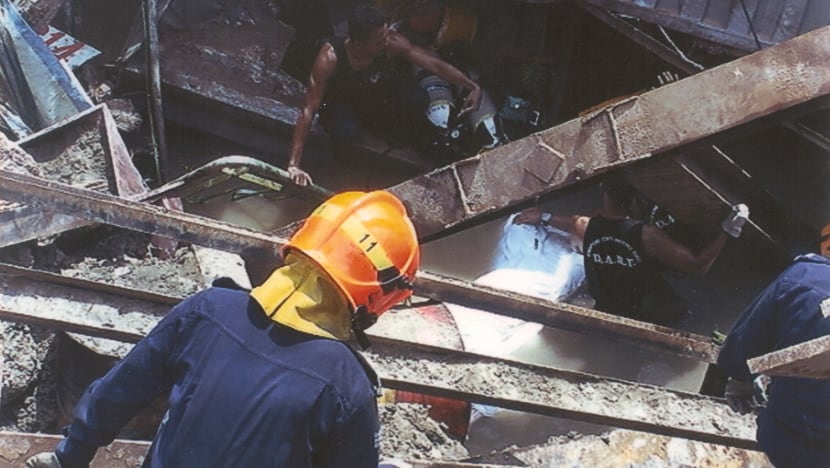SINGAPORE: “I can still (picture) the collapse," said an emotional David Ng as he breathed a deep sigh.
The engineer placed his right hand over his heart and was momentarily speechless as he surveyed a quiet grass patch that was the scene of a cave-in 20 years ago on Nicoll Highway.
“It’s a very emotional moment for me, standing here today,” he said, as he visited the site of one of Singapore’s worst worksite disasters.
“A lot of memories are still very vivid. There is grass here today but I remember the slope that formed due to the cave-in. I remember the emergency sirens of the SCDF (Singapore Civil Defence Force) vehicles,” he said.
“I even remember the position of our bus.”
Saturday (Apr 20) marked the 20th anniversary of the Nicoll Highway collapse that left four dead and three injured. One man was never found.
A young engineer with the Land Transport Authority (LTA) two decades ago, Mr Ng was deployed to the site of the incident.
Stationed in a parked bus that was his team's emergency response vehicle, he helped to monitor soil movement to ensure the area was safe for rescue operations.

Engineer David Ng, who was deployed to the site of the Nicoll Highway collapse in 2004, speaks to CNA about his experience.
“For the first three days, I did not go home. I was on the bus for the most critical 72 hours. When tired, we took a nap, then continued working,” he recalled.
He remembered mountains of debris, the yawning gap of the ravine and swirling dust and smoke.
“Knowing that there were lives involved in the incident was definitely traumatic, because it is really something you don’t expect as an engineer,” he said, recalling the immense weight on his shoulders as his team raced against time.
“It was never in my mind that something like this could happen. The (incident) changed my mindset altogether and (I realised) that such things do happen if we are not careful.”
A government inquiry found that an inaccurate assessment of soil behaviour and a design error of the support system underneath caused the collapse.
In the two decades since the incident, regular updates to safety protocols are now a mainstay in the construction industry. They include more independent checks, supervision and upskilling of engineers.
Several safety measures were introduced after the tragedy.
“The supervision is now done by an independent team. So when there is any glaring issue happening onsite that may indicate that the design is not safe, the supervision team will highlight it,” said Mr Ng.
“Hence, the inappropriate management of data and information on site is unlikely to happen nowadays.”
Instrumentation and modelling software are also constantly improving with technology, so engineers will be able to make more accurate assessments before work is done onsite.
There are also more registered professional engineers now, and firms providing professional engineering services have grown multi-fold.
Every six months, contractors also meet with LTA's senior management to discuss safety performances and flag potential issues.
"After the Nicoll Highway incident, we strengthened safety protocols and set requirements which were above prevailing industry standards," said the authority’s deputy chief executive Chua Chong Kheng.
Mr Ng is the chairman of the civil and structural engineering technical committee at the Institution of Engineers in Singapore.
The 50-year-old said his experience responding to the Nicoll Highway incident inspired him to further his studies in the field as he wanted to contribute to the safety of building works in the nation, particularly in the underground construction industry.

SCDF personnel are deployed into the water for search operations at the scene of the Nicoll Highway collapse in April 2004. (File Photo: SCDF Corporate Communications Department)
“I see a lot of improvement over the 20 years as a result of the incident,” said Mr Ng.
“Safety standards have increased and the level of design check has also increased significantly, pushing Singapore’s design standards to a higher level.”
Still, there's no room for complacency.
The future holds new challenges for construction in Singapore, with underground areas getting increasingly crowded and climate change leading to rising sea levels.
Mr Ng said more precautions need to be put in place, and those in the construction sector need to be more vigilant than ever.
“As the sea level rises, deep excavation projects will face higher water pressure that will exert more force on walls. There will also be risks of leakage, which could cause floods and put workers’ lives in danger,” he said.
Increases in temperature changes will also cause more expansion and contraction of building material, risking structural integrity, he said.
Following the tragedy, he worked as a project manager at the site until the completion of the Nicoll Highway MRT station along the Circle Line, which opened in 2010.
“I was there during the construction. We were so pressured to ensure that the station is being constructed safely and completed (on time),” said Mr Ng.
“Looking back, there were so many flaws in our construction industry. But we pulled ourselves together and changed things for the better,” he added.
“Today, we take the incident as a reminder. We have to be very careful in every step we take as an engineer because our designs dictate what happens on site.”
Continue reading...
The engineer placed his right hand over his heart and was momentarily speechless as he surveyed a quiet grass patch that was the scene of a cave-in 20 years ago on Nicoll Highway.
“It’s a very emotional moment for me, standing here today,” he said, as he visited the site of one of Singapore’s worst worksite disasters.
“A lot of memories are still very vivid. There is grass here today but I remember the slope that formed due to the cave-in. I remember the emergency sirens of the SCDF (Singapore Civil Defence Force) vehicles,” he said.
“I even remember the position of our bus.”
Saturday (Apr 20) marked the 20th anniversary of the Nicoll Highway collapse that left four dead and three injured. One man was never found.
A young engineer with the Land Transport Authority (LTA) two decades ago, Mr Ng was deployed to the site of the incident.
Stationed in a parked bus that was his team's emergency response vehicle, he helped to monitor soil movement to ensure the area was safe for rescue operations.

Engineer David Ng, who was deployed to the site of the Nicoll Highway collapse in 2004, speaks to CNA about his experience.
“For the first three days, I did not go home. I was on the bus for the most critical 72 hours. When tired, we took a nap, then continued working,” he recalled.
He remembered mountains of debris, the yawning gap of the ravine and swirling dust and smoke.
“Knowing that there were lives involved in the incident was definitely traumatic, because it is really something you don’t expect as an engineer,” he said, recalling the immense weight on his shoulders as his team raced against time.
“It was never in my mind that something like this could happen. The (incident) changed my mindset altogether and (I realised) that such things do happen if we are not careful.”
A government inquiry found that an inaccurate assessment of soil behaviour and a design error of the support system underneath caused the collapse.
SAFETY STANDARDS SINCE 2004
In the two decades since the incident, regular updates to safety protocols are now a mainstay in the construction industry. They include more independent checks, supervision and upskilling of engineers.
Several safety measures were introduced after the tragedy.
“The supervision is now done by an independent team. So when there is any glaring issue happening onsite that may indicate that the design is not safe, the supervision team will highlight it,” said Mr Ng.
“Hence, the inappropriate management of data and information on site is unlikely to happen nowadays.”
Instrumentation and modelling software are also constantly improving with technology, so engineers will be able to make more accurate assessments before work is done onsite.
There are also more registered professional engineers now, and firms providing professional engineering services have grown multi-fold.
Every six months, contractors also meet with LTA's senior management to discuss safety performances and flag potential issues.
"After the Nicoll Highway incident, we strengthened safety protocols and set requirements which were above prevailing industry standards," said the authority’s deputy chief executive Chua Chong Kheng.
NEW CHALLENGES FOR CONSTRUCTION SECTOR
Mr Ng is the chairman of the civil and structural engineering technical committee at the Institution of Engineers in Singapore.
The 50-year-old said his experience responding to the Nicoll Highway incident inspired him to further his studies in the field as he wanted to contribute to the safety of building works in the nation, particularly in the underground construction industry.

SCDF personnel are deployed into the water for search operations at the scene of the Nicoll Highway collapse in April 2004. (File Photo: SCDF Corporate Communications Department)
“I see a lot of improvement over the 20 years as a result of the incident,” said Mr Ng.
“Safety standards have increased and the level of design check has also increased significantly, pushing Singapore’s design standards to a higher level.”
Still, there's no room for complacency.
The future holds new challenges for construction in Singapore, with underground areas getting increasingly crowded and climate change leading to rising sea levels.
Mr Ng said more precautions need to be put in place, and those in the construction sector need to be more vigilant than ever.
“As the sea level rises, deep excavation projects will face higher water pressure that will exert more force on walls. There will also be risks of leakage, which could cause floods and put workers’ lives in danger,” he said.
Increases in temperature changes will also cause more expansion and contraction of building material, risking structural integrity, he said.
Following the tragedy, he worked as a project manager at the site until the completion of the Nicoll Highway MRT station along the Circle Line, which opened in 2010.
“I was there during the construction. We were so pressured to ensure that the station is being constructed safely and completed (on time),” said Mr Ng.
“Looking back, there were so many flaws in our construction industry. But we pulled ourselves together and changed things for the better,” he added.
“Today, we take the incident as a reminder. We have to be very careful in every step we take as an engineer because our designs dictate what happens on site.”
Continue reading...


